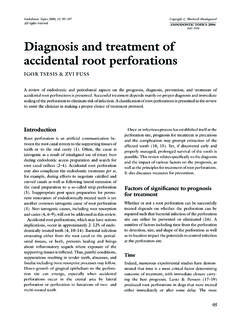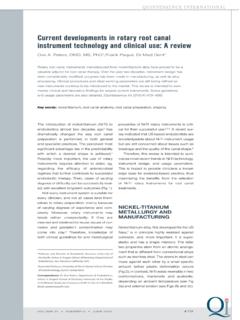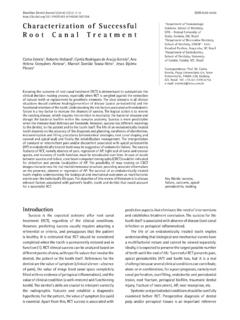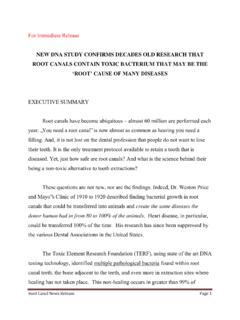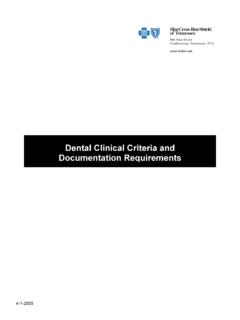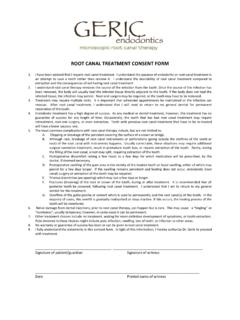Transcription of Methods of filling root canals: principles and …
1 Methods of filling root canals: principles and practicesJOHN WHITWORTHC ontemporary research points to infection control as the key determinant of endodontic success. Whileepidemiological surveys indicate that success is most likely in teeth which have been densely root -filled to within2mm of root -end, it is unclear whether the root canal filling itself is a key determinant of outcome. It is also unclearhow different materials and Methods employed in achieving a satisfactory root filling may impact on article provides an overview of current principles and practices in root canal filling and strives to untangle thelimited and often contradictory research of relevance to clinical practice and root canal treatment depends critically oncontrolling pulp-space infection.
2 In evaluating rootcanal-treated teeth, it is unusual for external assessorsto have full information on the Methods used and thedetail of infection-controlling steps. Attention there-fore tends to focus on aspects of treatment which canbe readily identified and measured, such as the radio-graphic nature, length and density of root fillings, withthe assumption that these are good proxy markers ofthe overall package of infection-managing care. It is notsurprising that the majority of epidemiological surveysin endodontics have focused on radiographic appear-ances alone (1), despite our recognized limitations inradiographic interpretation (2, 3), and acceptance thatthe radiographic white lines reveal only classic Washington study (4), although neverpublished in a peer-reviewed journal, set the tone byobserving that of endodontic failures werecausedby incomplete obturation.
3 Other well-estab-lished undergraduate textbooks have emphasized that lack of adequate seal is the principal cause ofendodontic failure (5), positions based on the bestclinical scientific evidence at the research points to cleaning andshaping of the root canal as the single most importantfactor in preventing and treating endodontic diseases(6), and it is difficult to endow root canal filling withthe same primary importance. But to take such viewstoo rigidly, and to use reports of periapical healingwithout definitive root filling as evidence that rootcanal filling is unnecessary (7 10) is to miss theimportant role it may play in securing short- andlong-term health (11, 12).
4 In technical terms, we anticipate that success will beassociated with root canals (prepared and) densely filledto within 2 mm of radiographic root end (1, 13).However, the body of high-quality clinical research onwhich such conclusions are founded is limited (14).Even less clear is whether a technically satisfactory root canal treatment will deliver health regardless of thematerials and Methods , or whether some are inherently better than others in terms of predictability, safety,consistency, healing, and tooth pressures and glossy advertising havenever been more prominent, but the debates are notnew.
5 As early as 1973, Brayton et al. (15) noted that Many techniques have been advocated for filling rootcanals. Controversies and disputes have arisen, dividingpractitioners into different schools of thought. To date,there is still very little evidence other than clinicalimpression to support or deny any particular technique. As no single approach can unequivocally boast superiorevidence of healing success (13), decisions may be basedon such factors as speed, simplicity, economics, or how itfeels in my hands. For some, there may be other issues atstake, such as the desire to keep up to date, todemonstrate mastery, to keep ahead of referring2 Endodontic Topics 2005, 12,2 24 All rights reservedCopyrightrBlackwell MunksgaardENDODONTIC TOPICS 20051601-1538colleagues, or to enliven the working day by the thrill ofthe fill (16) as unexpected canal ramifications aredemonstrated more consistently.
6 For others, issues suchas root strengthening, or a fundamental lack of confidencein established materials may be critical (17 19).The role of root canal fillings inendodontic successThe shaped and cleaned canal space represents anenvironment in which microbial communities havebeen eliminated or seriously disrupted and can nolonger promote periradicular disease (6, 20).But how is this condition preserved? Undue relianceon a coronal seal is probably unacceptable without firstfilling the canal system (21 23) with materials thatcontrol : by actively killing microorganisms (24)which remain (25) or which gain later entry to thepulp space.
7 By denying nutrition, space to multiply,and correct Redox conditions for the establishmentof significant biomass of individual microbes, or thedevelopment of harmful climax should do so long-term and without damaginghost approachesTextbook accounts describe a spectrum of fillingmethods (Fig. 1) ranging from paste-only fills, throughpastes with single cones of rigid or semi-rigid material,to cold compaction of core material and finally, warmcompaction of core material with sealer paste. It is likelythat most accounts have assumed the materials involvedto be traditional sealer cements (such as zinc oxide-eugenol pastes) in combination with metallic or guttapercha cones.
8 Sealer cements are usually regarded as thecritical, seal-forming gasket of the root canal filling(26), but paradoxically, as the weak link of the systemwhose volume should be minimized by core compac-tion (27, 28).Paste-only root fillingsPaste-only root fillings have a poor reputation in clinicalendodontics. Notable approaches have included highlytoxic resin cements such as Traitement SPAD and theoriginal, formaldehyde-containing Endomethasone(Septodont, St Maur des Fosses, France), which wereadvocated for rapid results in minimally preparedcanals.
9 Although success was reported, in some casesafter deliberate apical extrusion with a spiral paste-filler(29), such quick and dirty approaches appeared todeny the biological perspective that what came out ofthe canal was more important to success than whatwent in. Inadvertent accidents of over extension intovital structures such as the inferior alveolar canal left adistressing legacy for affected patients. Concerns werecompounded by the all too frequent insolubility andhardness of such materials, making removal for re-treatment a challenge to the most skilled of operators(30, 31).
10 Even with fluid materials which are regarded as blandand biocompatible, risks of erratic length Classic spectrum of filling techniques,emphasizing the desirability of minimum sealer volume,from (A) paste only (least desirable), through (B) singlecones with paste, and (C) cold lateral condensation, to(D) thermoplastic of filling root canals: principles and practices3during application are recognized. Fannibunda et al.(32) reported a case of inferior alveolar nerve para-esthesia, which followed the inadvertent extrusion ofmolten gutta percha.
